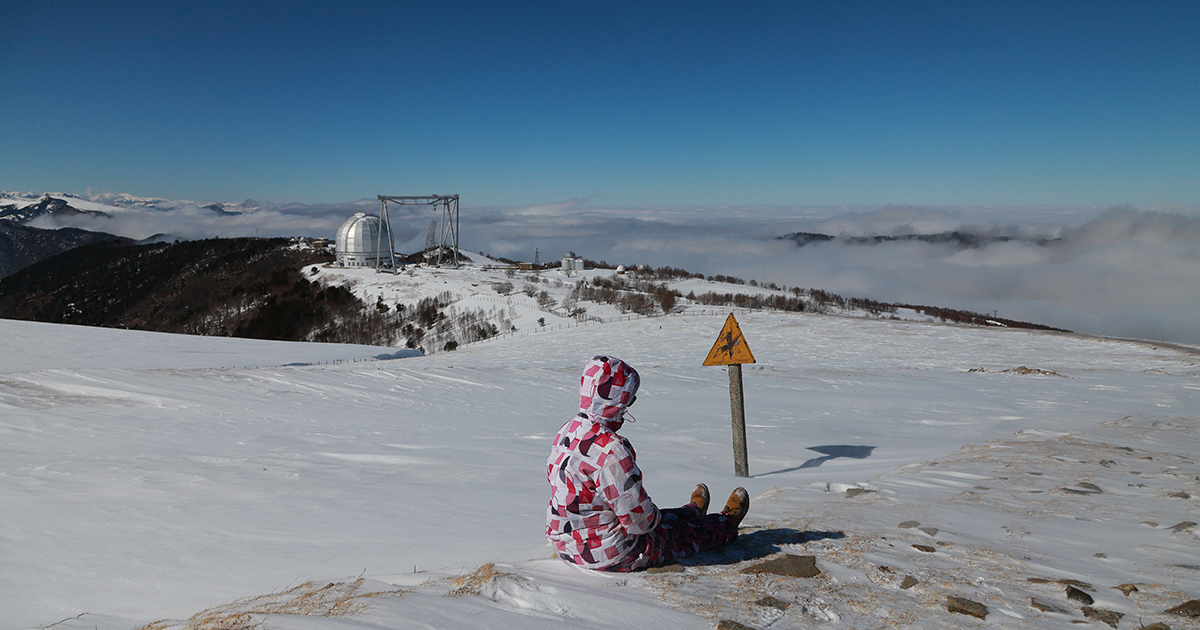
When the telescope is not working, astronomers are sad
Many people know that you can look at the sun at least twice with a telescope. But this is if the telescope is small. In the case of our BTA, the ray would probably neatly burn the hair on the back of the head. Unfortunately, we will never know this for sure, because we do not conduct such experiments (although I will still give preliminary calculations about the rate of boiling of the brain under the cut). But we spend others, no less interesting.
It so happened that I'm not a very smart person five years ago I fell ill with space and traded work in IT for graduate school at the Special Astrophysical Observatory. And now I want to show how scientists work and survive high in the mountains of the North Caucasus. Under the cut will be our astronomical iron (a little) and the inside of the largest telescope in Europe, of those that are not shown to tourists on excursions.
Big such a telescope
You will almost certainly know this, but let me remind you that territorially CAO is Karachay-Cherkessia. Our largest Russian telescope is called BTA - the Big Azimuthal Telescope (although actually there are also telescopes in the observatory). And it is located at an altitude of 2100 meters above sea level, at the foot of Pastukhov Mountain. The diameter of its main mirror is 6 meters, and it is still the largest in Eurasia.
Once we know the diameter of the BTA mirror, we can calculate how long it takes to boil the brain under the action of a focused ray from the Sun. So, the power of solar energy with 1 square. m - 1350 watts. We consider the area of a mirror according to the formula known from school - (the main thing to remember here is that 6 meters is the diameter). Total we have 38.2 kilowatts (or 38.2 kJ per second) - the power of the mirror. The heat capacity of the brain, according to the tables that Meklon dug up somewhere : 3352 J / (kg · deg). The mass of the average brain is 1.5 kg. Let's pretend to be a hose, that is, a physicist, not a biologist, and say that in order to boil the brain, we need to heat it with before . We consider: kj Well, now it’s enough to divide the last result into the first and get enough time for boiling: 8.4 seconds. Although actually when the proteins in the brain will coagulate, and the subject will not be able to escape in just one second. But it is better to heat it well. Prion diseases are not very pleasant.
The telescope is located on the top of the mountain, and the village with astronomers is a kilometer lower (but this is if you are able to go strictly vertically up and down, and for people without superpowers there is a track 17 km long). In Soviet times, during the set, observations were carried out directly on the telescope, now almost all observations are made "from below" from the village.

Telescope Upgrade
Recently, we survived almost a year and a half without observation, while we were changing the mirror, and then a very talentedly broken observation device was being repaired and the mirror was changing again (I will also tell you about the repair of the device, but later). Details of this long story about the mirror can be found, for example, here .
But finally, from October 1, observations in normal mode resumed. Although generally not quite regular, because the device, which will be discussed below, is now in test operation. The mode "we, of course, will try to observe the entire program, but not the fact that all the time it will not go to debugging bugs." Observations resumed, which means that before the set (as it is called several nights in a row with one responsible observer), you need to go up the mountain to install the device.
So let's go. Together with the device on a duty machine, proudly referred to as a loaf or tablet to this day (depending on the region of your residence).

The same loaf that carries an optical instrument for observation
All parts of the device are neatly packed in several boxes that we unload into the machine. At least one of those responsible for installing the device will have to go with him to keep the device in turns. Serpentines, mountains, mother-in-law's tongues (the so-called 180-degree turn on a mountain road), you know.

The guys are working, and I am running behind the scenes with a camera and bothering everyone
If you still have not found application for your Tetris skills, then here we have found, look, what a beauty.
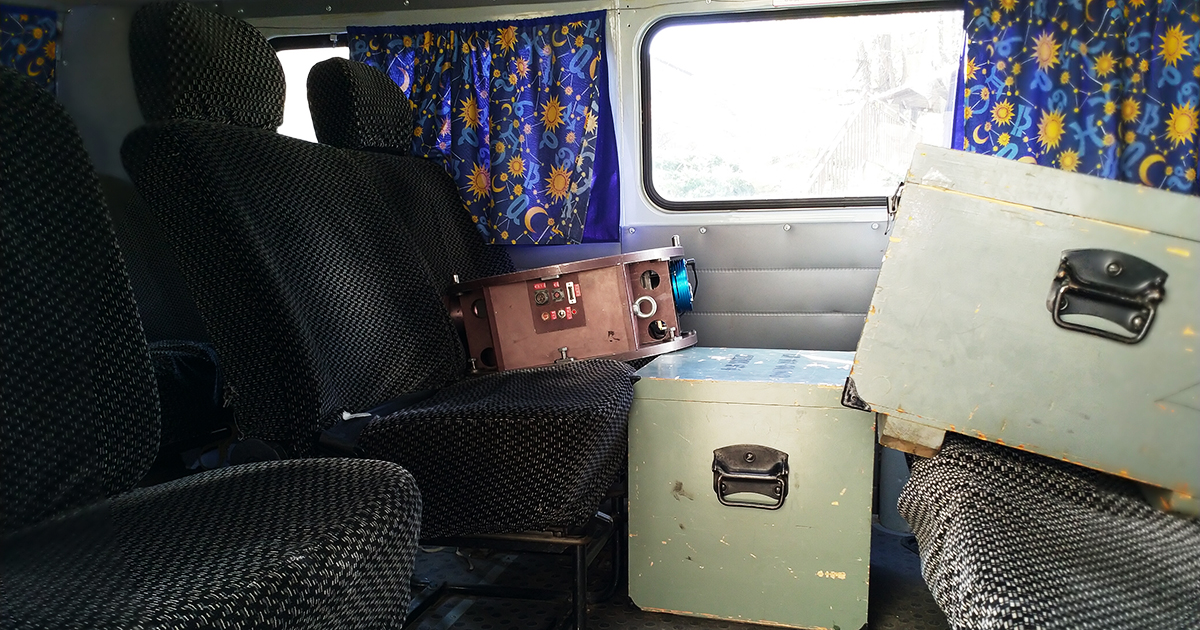
Yes, even inside the car we can watch the stars
Booted and drove off. In the meantime, we can go and talk about the device. Do you know this feeling when you open the packaging with a new graphics card? Astronomers have the same thing when they admit you for the first time before observations, only iron weighs more and costs significantly more. I’ve been observing from the first year, and a month ago I also became a responsible observer (that is, I can independently conduct observations on the BTA, I know the observation methodology and don’t panic when something goes wrong, and my name can also be found on site with the schedule).
We will install SCORPIO (Spectral Camera with Optical Reducer for Photometric and Interferometric Observations, often we simply call it “Scorpio”). This is the focal reducer of the primary focus aperture. It was developed in our laboratory for spectroscopy and photometry of extragalactic objects (LSFVO) in 2000.
At SCORPIO, the programs of our LSFVO, other laboratories of the Northern Administrative Okrug and applicants, which have no relation to the Northern Administrative Okrug, are being carried out (it only seems that the astronomical world is actually small, very small). The observation schedule can be found in the public domain on the observatory website.

General BTA Observation Time Competition
According to its definition, a reducer is a mechanism whose main function is reduction, which is also reduction. That's just the main feature of SCORPIO - it is an increase in the aperture ratio of the telescope (the BTA aperture in the primary focus is F / 4, for the BTA + SCORPIO F / 2.4 ligament). It turns out some contradiction in the name, right? The aperture reducer increases this same aperture.
I propose to solve the riddle of the name yourself, and then check the answer.
The answer is simple: here, in the title, the word “focal” is missing, due to the fact that no one pronounces the full name in the lab and observatory (well, for a long time). The reducer reduces the equivalent focal length d, thereby increasing the aperture of the F / d system (where F is the focal length that remains unchanged).
For observations, we need a system of three components: a SCORPIO aperture reducer, a primary focus adapter, and a CCD receiver. When assembled in the laboratory, the device looks like a set of iron boxes, since all fragile optical parts are hidden away from crooked hands.
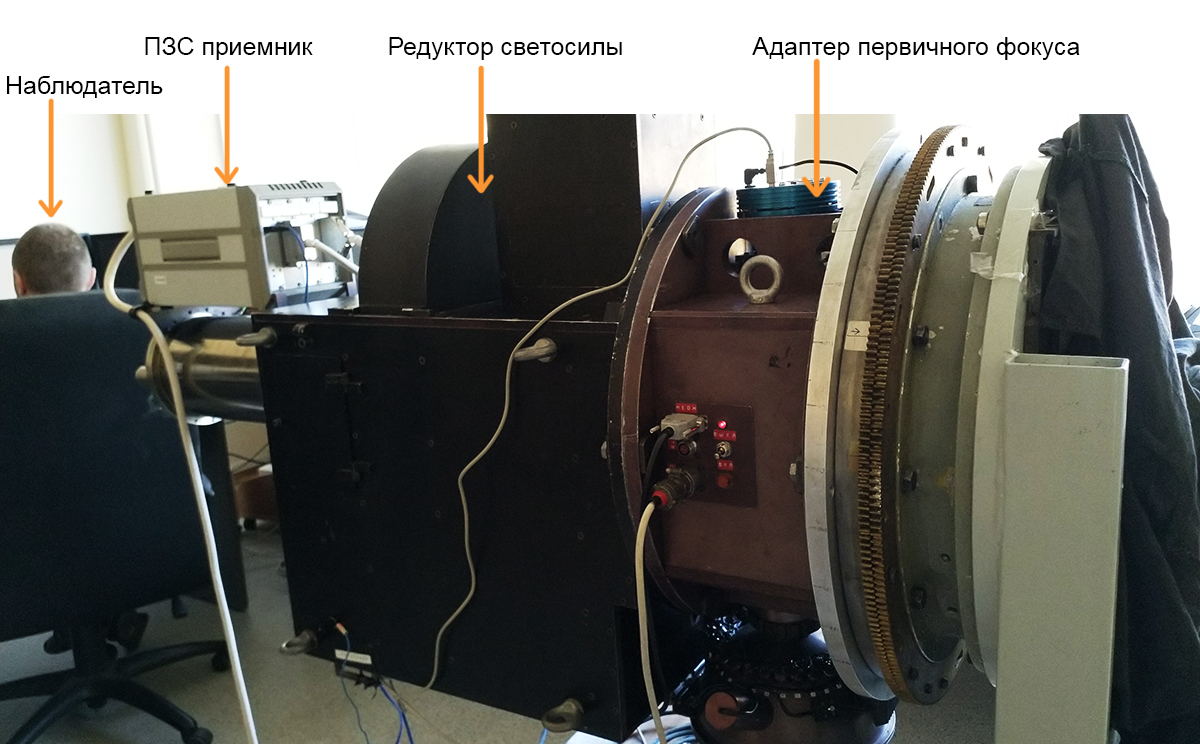
Primary focus adapter, aperture reducer and CCD receiver, assembled together (the observer is not included in the kit, but his personality is extremely important for conducting quality observations)
The reducer includes spectrograph optics and a multi-slit block, the adapter platform includes optics and lamps for spectrograph calibration (the integrating sphere for calibrations can be seen at the bottom of the spectrograph), fields for searching for guiding stars and spying, but in the CCD detector, of course, it includes the CCD detector and cryostat for cooling (matrix operating temperature is about -130 degrees Celsius).
The most interesting of all this, of course, is the gearbox. Because there is all the optics and magic of transforming cloudy weak points in the sky into the spectra of galaxies (well, not only into galaxies and not only into spectra, Scorp is able to work both in the spectrograph mode and in the direct image mode, which we are all used to ) In the context and in the observer's training manual, SCORPIO looks like this:

If you do not go into details of the optical scheme, then all the most interesting is indicated in the figure above. A collimator for receiving a parallel beam of light from an object of observation. Two wheels with a set of filters, masks and slots, which we can change from the instrument control program. Medium- and narrow-band filters, and a slit for obtaining spectra of objects are usually installed on the first wheel, and wide-band filters and a mask for gapless spectroscopy on the second wheel. The zero position in both wheels is always left empty, so that when observing, use any of the installed filters. A variety of information about the physical characteristics of objects can be pulled out from flows in different filters: temperature, type of object, chemical composition, etc. We have rearranged the Fabry-Perot interferometer to the next-generation device, so we will not talk about it this time.
Under the dome
While I was broadcasting about SCORPIO, we drove to the telescope. The entrance for excursions does not suit us, so we will go from the service passage, which is to the left. Here he is:

Further we pass along the corridor between the rubble of various plants, the meaning of which is clear only to engineers. Although I call them that, they are in fact mechanical workshops working for the needs of a telescope. All corridors are curved according to the shape of the dome in a circle, which greatly disrupts the orientation in space for the first time you visit the telescope.
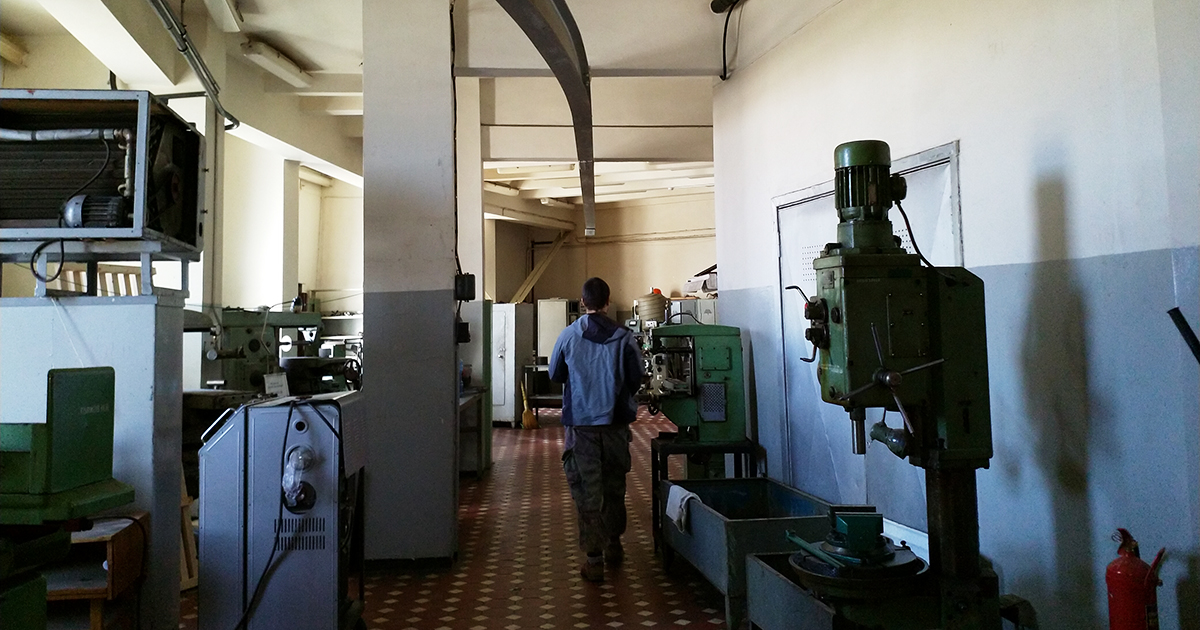
We get to the elevator, rise and get into the domed room. It is expected to be very large (53 meters only in height). The dimensions of the dome create various interesting effects such as microclimate and vortex flows indoors, which creates additional difficulties during observations.
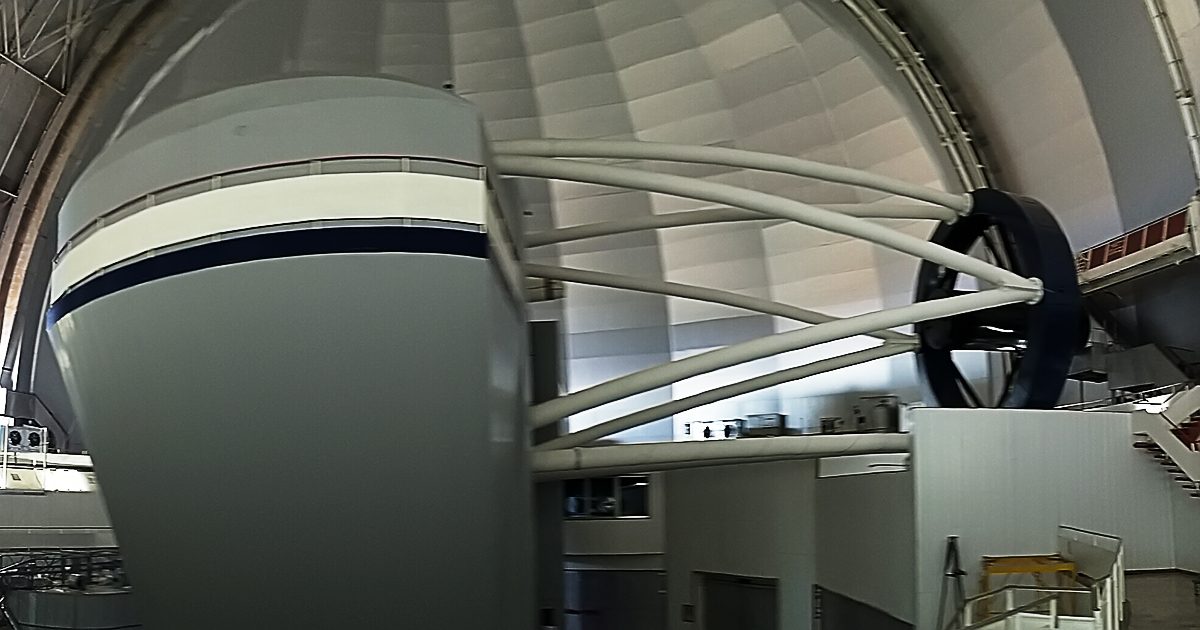
Before changing instruments, the telescope is always brought into the parking lot, in the horizon position. A staircase leads to the parking lot, which allows you to climb into the observer's cabin using a telescope. Only no one calls it the observer’s cabin, everyone briefly says “glass”. Previously, an observer climbed into a glass and spent the night there, taking photographic plates with space objects. If it occurred to you now that this is very romantic, then throw away this thought urgently: in the glass, the temperature was almost like in the street, plus Richie’s cassette was almost at the level of the “floor” of the glass, so the observer’s body position was very interesting.
Richie's cassette is a device for taking astronomical images. A cassette with a photographic plate with a photosensitive emulsion was installed in the central part. Microscopes and rulers are needed for calibrating and moving an object across a field. It looks like this:
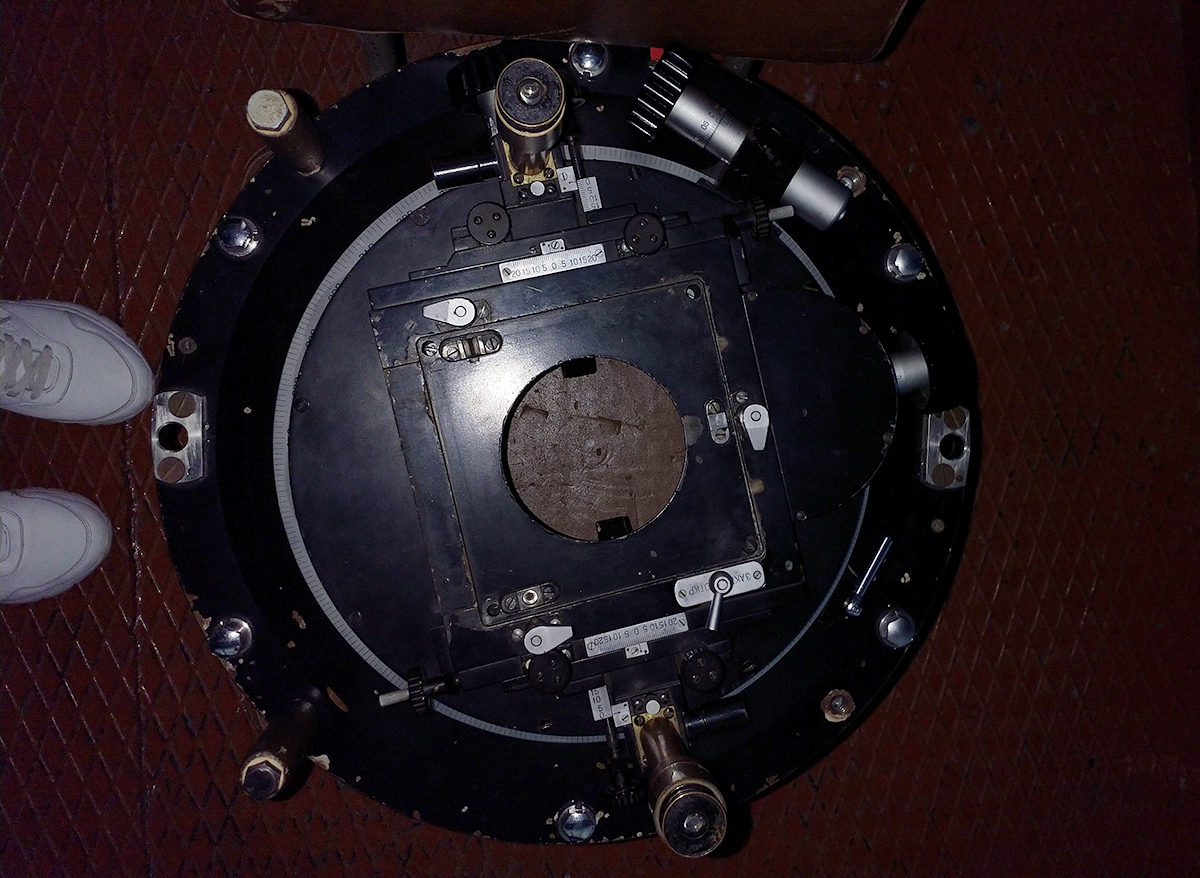
We climb into a glass
Now in the glass there is a different photo-receiving equipment (for example, our SCORPIO). And the observer is warm and comfortable.

Docking Space Telescope with Reality
In a glass without appliances, there is enough space for 3-4 people to compactly fit in it. The diameter of the glass is more than 1.5 meters, the height (or length) is slightly more than about four. A hole (oh, sorry, a constructive hole) in the center is where the adapter platform is installed, so called because it serves as an adapter between the telescope and the device. And the hole itself is a rotary table, the rotation of which we also use in observations when it is necessary to set the position angle (in spectral observations, for example, in order to optimally draw a gap through the object).

SCORPIO weighs about 50 kg, the adapter platform weighs as much. Therefore, inside the glass, it is placed through the upper hatch in the glass with the help of a crane, the remote control of which brings back memories of the Soviet tube past:

The process of moving the device (SCORPIO + platform) against the background of a telescope. It is important to be very careful and not to hook the telescope, not to drop the device and still a lot of things to do. Still, optical systems are fragile, even if they are in an iron box.
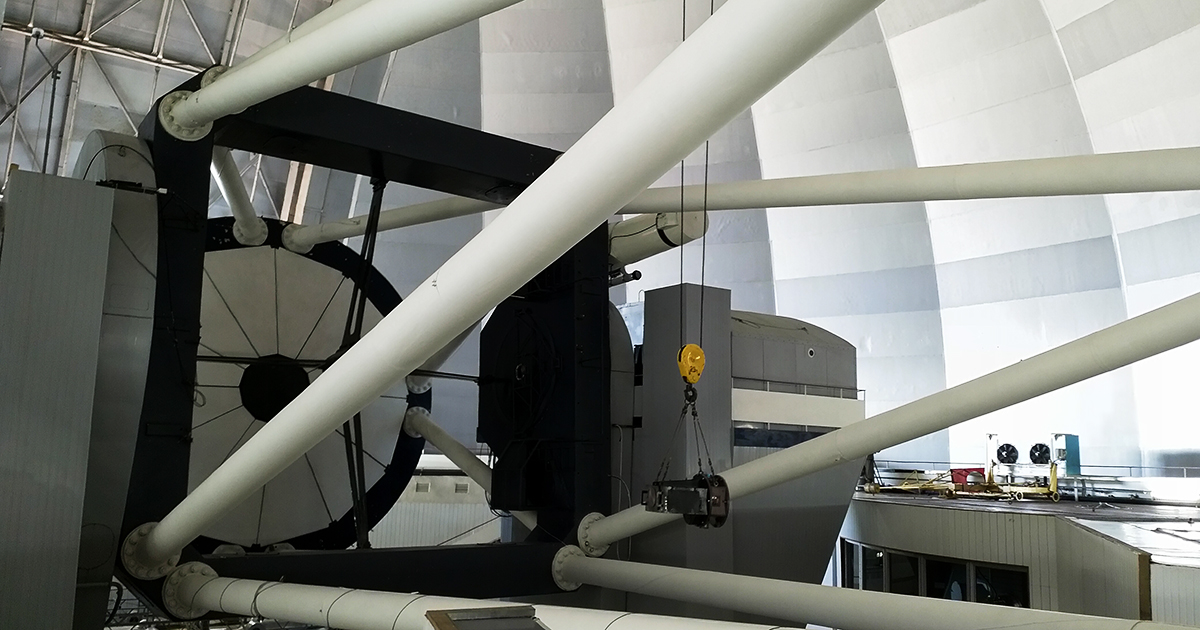

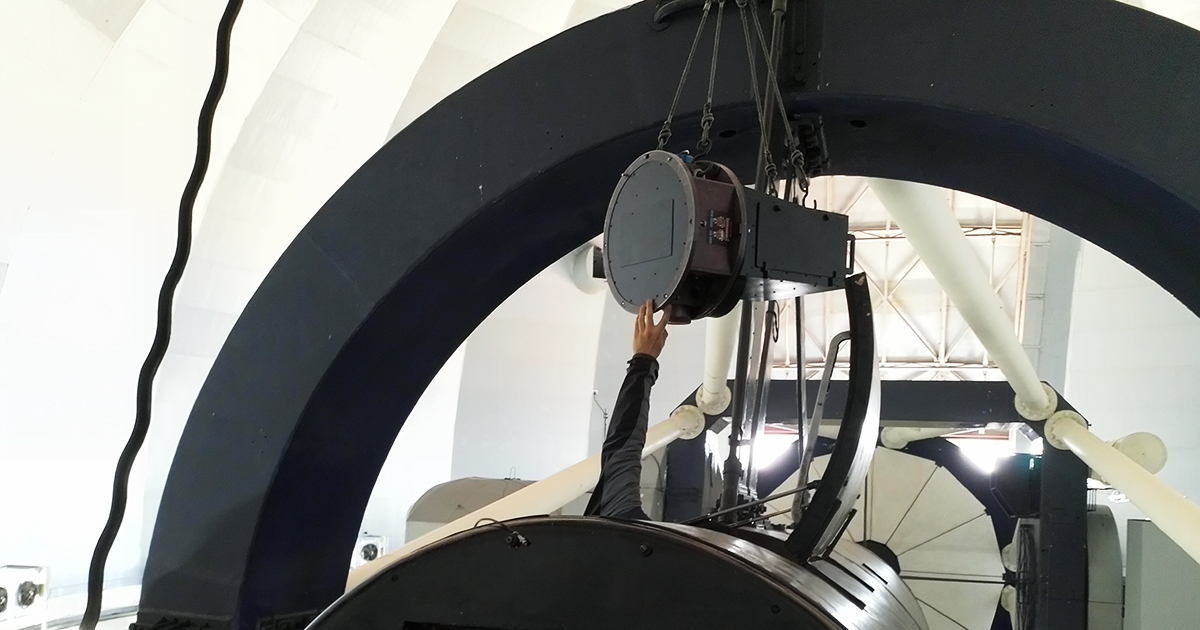
When the device is caught and placed inside, the matter remains small: put it in place and tighten the bolts with the wrench.
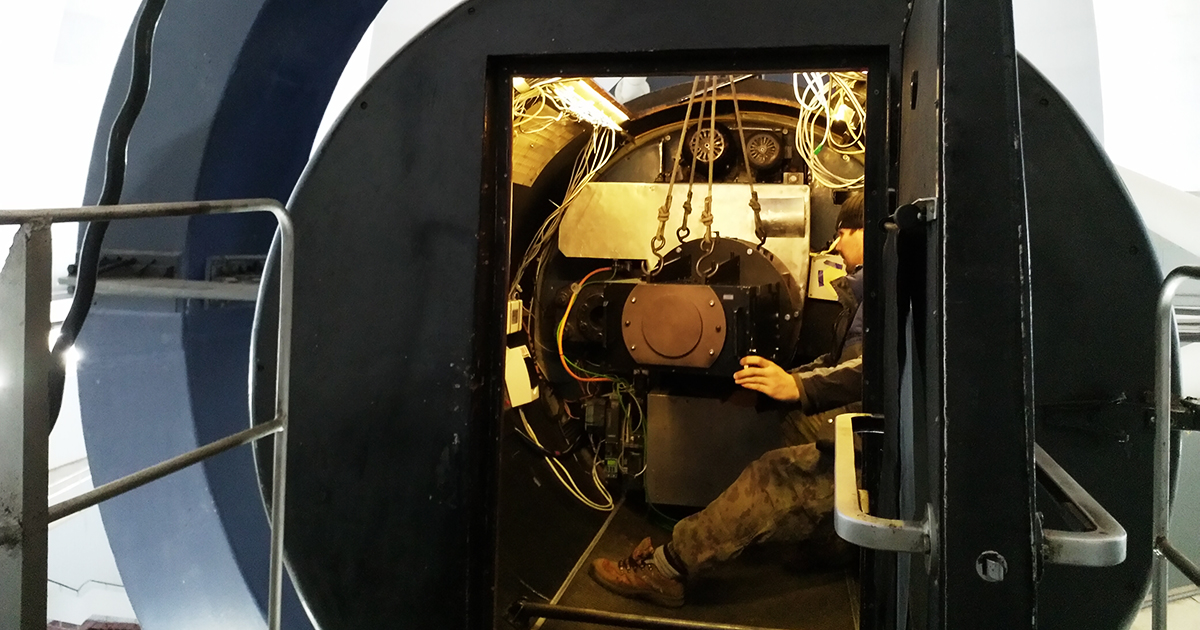
And also connect with the integrating sphere and the camera.

The integrating sphere or Ulbricht ball is used to take calibrations: the flat flats familiar to astrophotographers - frames for uniform field illumination and unfamiliar neons (neon) - frames for calibrating the wavelength scale. The sphere in our device can be illuminated by a quartz lamp, or by LEDs, or by means of a lamp with He-Ne-Ar filling. The latter is just used to remove neons, and the first two are suitable for flat.

Ulbrecht sphere close up. In the "horns" are a quartz lamp and a lamp with He-Ne-Ar filling, small cylinders around the perimeter - LEDs
Before installing the matrix on the device, liquid nitrogen must be poured into its cryostat (but everyone says “pour nitrogen into the matrix”). The observatory buys nitrogen in Nevinnomyssk, which is very close and convenient.

Finally, all the steps have been completed, it remains to connect everything together, and the device is ready for a performance check.

After installing SCORPIO, we start the computer, which is located inside the device. We connect remotely there on a telescope from a laptop and check whether the wheels with filters and grilles move. Turn on the matrix, initialize it. We shoot the calibration frames neon and flat, check them for adequacy to the physical picture of the world. We check the operation of the spy system and guide. A guide is needed for guiding (guiding) the telescope with the help of stars, so that during long exposures the studied object does not crawl out of the instrument’s field, leaving only a long trace instead of a spectrum or image (do you still remember that the Earth rotates?). We collect things and go to prepare for the observations, which will also pass through a remote connection to the device.

Pages turned out quite a few, but almost failed to talk about the principles of the device. Probably because the article was originally conceived as "one day in the life of an astrophysicist." So to be continued. I will be glad to questions (at least I hardly explained all the astronomical jargon used in the article).
And a few thanks at the end. This article would not have come without my dear colleagues from the laboratory of spectroscopy and photometry of extragalactic objects, who listened to my stupid questions (for the whole three years!) And answered them, without my supervisor who conducted a short scientific edition of this text and, of course, without Meklon , who told me a million times that the life of astronomers is probably interesting on Habré, and who is generally to blame for the fact that this article was written and published.
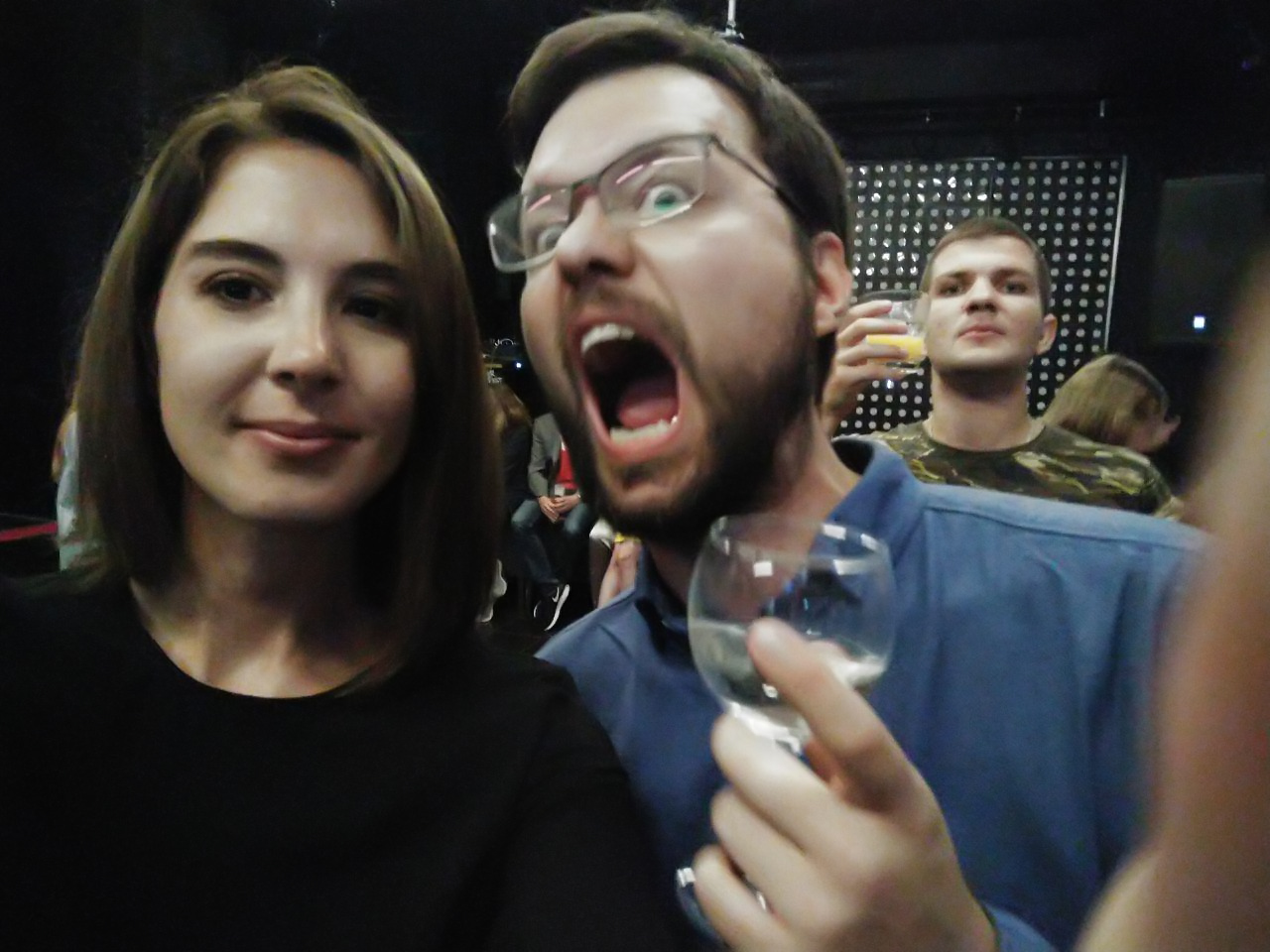
And a little about very sad
While I was writing this article, the French academician Georges Courtes, who in the 50s came up with the idea of a speed reducer, passed away. The older generation of our laboratory collaborated with him very closely and fruitfully, so I think it is right to devote this article to his memory. In the late 70s and early 80s, Kurtes often came to the CAO, and one of the results of his joint work was the map of the M33 galaxy in the H_alpha line (this is the spectral line of the Balmer series for hydrogen ), made on his first in the world aperture reducer, which is carefully stored in our laboratories (F / 1!). You can read a little more about the great experimenter in the blog of my colleague from the laboratory.

Map of the M33 galaxy in the H_alpha line, obtained during observations from 1979 to 1985 at the BTA by a group of astronomers Courtes, G .; Petit, H .; Petit, M .; Sivan, J.-P .; Dodonov, S. (and the latter is my supervisor). Link to the article